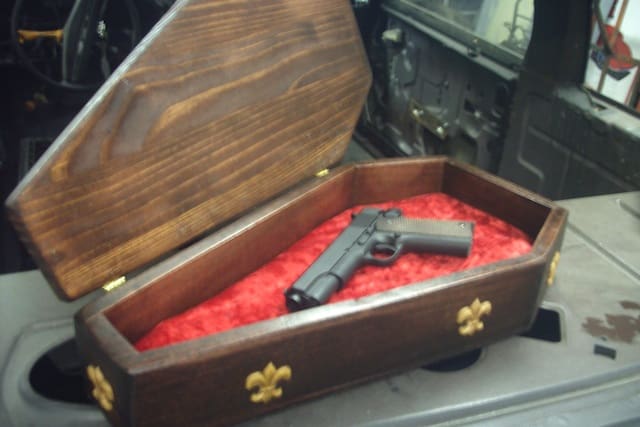When discussing the immediate impact of a life-or-death encounter, gun gurus often refer to the “fight of flight response.” In the blink of a widened eye, your brain dumps adrenaline into your system. Blood flows away from your extremities, protecting your arms and legs from blood loss. At the same time, the shift feeds your rapidly beating, super-heating heart with highly-oxygenated blood (thanks to rapid breathing). Within seconds you’re ready to fight the bad guy—albeit with limited fine motor skills—or run like hell. Yes, well, that’s only two thirds of the story. There is another natural response to life-threatening danger: freeze.
Now that armed encounters are captured on video on a regular basis, it’s easy to see that that vast majority of people in a potentially deadly encounter do not fight or run. They do nothing at all. They freeze.
Freezing is the third potential response to danger, and there’s nothing wrong with it per se. Many animals have no defense against predators save remaining stock still and hoping they’re not noticed. Hence the evolution of camouflage. And pack behavior, wherein the first responder gets eaten first. Sometimes it is best not to move a muscle. In fact, in most cases, it’s the default option. Hence its prevalence.
Note the word “sometimes.” Surviving a life-threatening situation, or high school for that matter, depends on your ability to match the appropriate response to the appropriate situation. You don’t always want to fight—especially if you’re going to get eaten/beaten. You don’t always want to run—especially if you’re going to lose the race and get eaten or diminish your social status. And you don’t always want to freeze, in case you get “volunteered” for some dorky club. Or eaten.
As you probably know from personal experience, the fight, flight or freeze response is a complicated business. Which of the big three occurs when your mind and body are on DEFCON 1 depends on the nature and severity of the threat, your genetic makeup, your social status within a group, and environmental limitations. Sometimes you choose a course of action, sometimes it chooses you.
In terms of your behavior during extreme danger, it’s useful to consider the options listed on the sign on Ted Turner’s desk: “Lead, follow or get out-of-the-way.” Lead (fight), follow (stand there and do as you’re told) or get out-of-the-way (flight). But here’s the kicker: you need to have all three options available.
For example, an armed robber enters a convenience store. If his attention is entirely on the clerk, you’d best draw your weapon, find concealment and freeze. Or just freeze. If he fires a warning shot and you have a clear chance to run out of the store, flight is right. If he shoots the clerk, and there’s no clear egress, you need to fight.
If you don’t have all three possibilities teed-up—fight, flight or freeze—or if you choose the wrong one, you could pay with your life. But again, those are the behaviors. Your psychological journey follows another pattern. One which seldom gets a look in. It’s known as the grieving process.
Grieving happens all the time, whenever we change from the familiar to something new. And what could be a bigger change than going from safety to life-threatening danger? In an instant, your nice “old” safe predictable world has been replaced with complete uncertainty, doubt, fear and chaos. Your mind naturally grieves for the old way. But if you want to do it effectively, you have to do it FAST. And, maybe, cut the process short.
In her book The Model of Coping with Dying, Dr. Elizabeth Kubler-Ross identified a structure for human grief known as The Five Stages of Grief. It’s best remembered as DABDA (Yabba-Dabda-Doo). Here they are, with my comments on their applicability to an armed encounter in brackets.
1. Denial — “I feel fine.”; “This can’t be happening, not to me.”
Denial is usually only a temporary defense for the individual. This feeling is generally replaced with heightened awareness of possessions and individuals that will be left behind after death.
[Denial triggers the freeze response. “This can’t be happening to me” tells your subconscious nothing is happening to you. So you don’t need to do anything. At least not until you figure it out. Obviously, the sooner you get out of denial the better. One answer, train yourself with a key word or phrase to stimulate action. Mine is “Move!”—although that risks moving prematurely, I don’t want to be remembered as Big Chief Sitting Duck.]
2. Anger — “Why me? It’s not fair!”; “How can this happen to me?”; ‘”Who is to blame?”
Once in the second stage, the individual recognizes that denial cannot continue. Because of anger, the person is very difficult to care for due to misplaced feelings of rage and envy.
[Anger triggers the fight response. IF you’re going to attack, you need to do it quickly and viscously. But you must keep control of your anger long enough to perform a lightning quick pre-flight check. How many bad guys, what weapons, what distance, what angles, etc. Force-on-force and shoot – don’t shoot training are critical.]
3. Bargaining — “Just let me live to see my children graduate.”; “I’ll do anything for a few more years.”; “I will give my life savings if…”
The third stage involves the hope that the individual can somehow postpone or delay death. Usually, the negotiation for an extended life is made with a higher power in exchange for a reformed lifestyle. Psychologically, the individual is saying, “I understand I will die, but if I could just have more time…”
[Some people believe they can talk their way out of a potentially lethal situation. Sometimes you can. “Take my money, go.” Talking therapy is especially effective if you’re using it as a distraction, to plan a flight response. BUT sometimes you can’t bargain your way out of trouble. Sometimes any attempt to communicate enrages the bad guy and makes things far worse for everyone. There’s another problem with this strategy: you’ve lost your anger. Working yourself up into a murderous rage will be much, much harder.]
4. Depression — “I’m so sad, why bother with anything?”; “I’m going to die… What’s the point?”; “I miss my loved one, why go on?”
During the fourth stage, the dying person begins to understand the certainty of death. Because of this, the individual may become silent, refuse visitors and spend much of the time crying and grieving. This process allows the dying person to disconnect from things of love and affection. It is not recommended to attempt to cheer up an individual who is in this stage. It is an important time for grieving that must be processed.
[Roger that. If a person in a self-defense situation becomes unresponsive or, indeed, catatonic, it’s not the end of the story. In fact, they’ve worked their way from denial to a full appreciation of the gravity of the situation. They look lethargic, like they’re not a threat to the bad guy or guys. But oh yes they are.]
5. Acceptance — “It’s going to be okay.”; “I can’t fight it, I may as well prepare for it.”
In this last stage, the individual begins to come to terms with her/his mortality or that of a loved one.
[Basically, the “victim” has accepted the fact that they could lose everything, so they have nothing to lose. I’ve heard stories of this response from various cop confessors: the quietest guy in the room suddenly becomes an animal, without any regard for his or her personal safety. The fight for their lives, without any concern that they may lose it.]
Recognizing these stages in others is more important than fully understanding the fight, flight or freeze response. It allows you to analyze potential allies and plot strategy using them as resources.
For you personally, I recommend DA. Get out of denial as quickly as possibly, get as angry as you can (perhaps using expletives in you mind) and repeat this loop: stay, run, gun. Those are your three self-defense options. Know them. Know when to use them. And you’ll have a much better chance of survival. Put another way, beware of the man (yourself) with one plan.





Speaking of the five stages of grief, an overlooked comic gem of the 90’s – WIngs had an episode that dealt with just that. Here’s the YouTube link: http://youtu.be/X7kxKQkfY0M – the scene in question takes place at 4:18 in to the clip. But if you watch the whole thing, you’ll learn about Faye’s new hobby – shooting skeet.
As someone who knows about very recent grief first hand, I can tell you that the best approach is to blow past the first four stages as quickly as humanly possible and get to acceptance.
Denial, or refusal to accept the truth, is a sure exit from this life. Anger may motivate us to fight, but it clouds judgment and makes us take unnecessary chances. We’ve seen the result of bargaining — the hostage begs for his life, says “I won’t tell” — and gets shot. Depression = potential for suicide. Acceptance is recognition of the truth, which is a baby step from “normal.” All of us think more acutely and act more effectively when we are thinking “normally.” We probably shoot better, too.
I reckon, five stages are three too many for someone in a life-or-death situation. There isn’t time, and they can’t just jump to acceptance.
As I pointed out in the article, you need a HUGE amount of aggression when you take on the bad guy or bad guys. (If you do.) The more animus the better.
So it’s get out of denial STAT. Then nurture, control and release your aggression (if you do), until after the deal goes down. Then you get to start all over again and go through the entire process (my life before the DGU, my life after).
I prefer righteous anger turned to violent controlled rage-by practice and experience. It is how we get that extra adrenaline, use shock and awe, how I was trained and why I was good-it is an innate trait in me. “kill or be killed” is the way-even if you may go down, take him with you. How do you think I got this nickname? The hardest part is turning it off afterwards…
CUJO, I prefer the cold-blooded approach, just like shooting a Dirty Bird. I don’t get angry at the target, I just try to punctuate it. There’s plenty of time for anger at the inquest.
Can’t help it-made that way, plus two stabbing scars and 5 skull fractures later…Momma said I was born to have been an outlaw biker or a bounty hunter! Point taken though, thank you. Mike the Barbarian
Comments are closed.